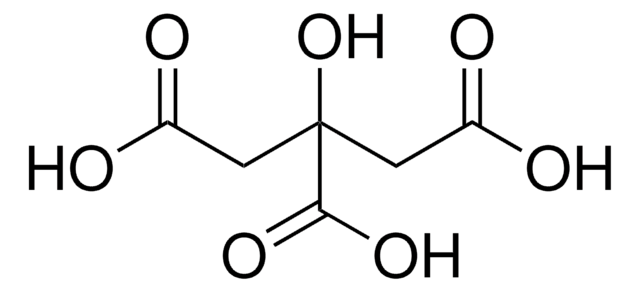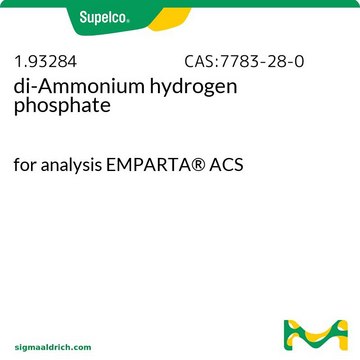215996
Ammonium phosphate dibasic
ACS reagent, ≥98%
Synonym(s):
Ammonium hydrogenphosphate, Diammonium hydrogenphosphate, di-Ammonium hydrogenphosphate (sec)
Select a Size
About This Item
powder
Recommended Products
grade
ACS reagent
Quality Level
Assay
≥98%
form
crystals or chunks
powder
impurities
≤0.005% NH4OH pptd.
≤0.005% insolubles
pH
7.7-8.1 (25 °C, 5%)
mp
155 °C (dec.) (lit.)
anion traces
chloride (Cl-): ≤0.001%
nitrate (NO3-): ≤0.003%
sulfate (SO42-): ≤0.01%
cation traces
Ca: 0.001%
Fe: ≤0.001%
K: ≤0.005%
Mg: 0.0005%
Na: ≤0.005%
heavy metals (as Pb): ≤0.001%
SMILES string
N.N.OP(O)(O)=O
Looking for similar products? Visit Product Comparison Guide
1 of 4
This Item | 79762 | 1029986 | 09839 |
|---|---|---|---|
| form crystals or chunks, powder | form crystals | form - | form - |
| assay ≥98% | assay 99.0-101.0% (T) | assay - | assay ≥99.0% (T) |
| Quality Level 200 | Quality Level 100 | Quality Level - | Quality Level 200 |
| grade ACS reagent | grade - | grade pharmaceutical primary standard | grade - |
| anion traces chloride (Cl-): ≤0.001%, sulfate (SO42-): ≤0.01%, nitrate (NO3-): ≤0.003% | anion traces - | anion traces - | anion traces chloride (Cl-): ≤5 mg/kg, nitrate (NO3-): ≤10 mg/kg, sulfate (SO42-): ≤20 mg/kg |
| mp 155 °C (dec.) (lit.) | mp 155 °C (dec.) (lit.) | mp 155 °C (dec.) (lit.) | mp 155 °C (dec.) (lit.) |
General description
Application
- To synthesize tetrahydrobenzo[b]pyranderivatives via three‐component condensation reaction.
- In the solvent-free Biginelli reactions.
- To synthesize bis(indolyl)methanes via solvent-free reaction of indole derivatives and aromatic or aliphatic aldehydes.
Storage Class Code
11 - Combustible Solids
WGK
WGK 1
Flash Point(F)
Not applicable
Flash Point(C)
Not applicable
Choose from one of the most recent versions:
Already Own This Product?
Find documentation for the products that you have recently purchased in the Document Library.
Customers Also Viewed
Protocols
gc-analysis-of-a-37-component-fame-mix-g004278
Our team of scientists has experience in all areas of research including Life Science, Material Science, Chemical Synthesis, Chromatography, Analytical and many others.
Contact Technical Service









